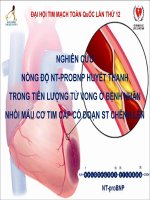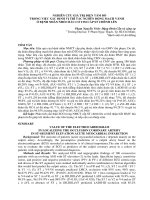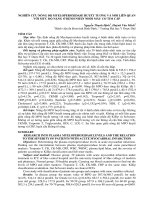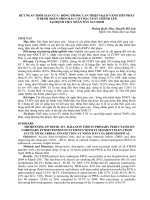NGHIÊN cứu GIÁ TRỊ điện tâm đồ TRONG VIỆC xác ĐỊNH vị TRÍ tắc NGHẼN ĐỘNG MẠCH VÀNH ở BỆNH NHÂN NHỒI máu cơ TIM cấp ST CHÊNH lên
Bạn đang xem bản rút gọn của tài liệu. Xem và tải ngay bản đầy đủ của tài liệu tại đây (544.95 KB, 6 trang )
NGHIÊN CU GIÁ TR
TRONG VINH V TRÍ TC NGHNG MCH VÀNH
BNH NHÂN NHP ST CHÊNH LÊN
Phm Nguyn Vinh- n và cng s
1
Tri hc Y Phm Ngc Thch, Tp H Chí Minh;
2
Bệnh viện II Lâm Đồng
TÓM TT
Mc tiêu: Hu qu ca bnh nhân NMCT cp ph thu ph
d ng mch th phm dp vin là mt du chng lâm sàng quan
trng. Mc tiêu ca nghiên cu này nhm kho sát giá tr ECG khi d h phm
trong NMCT cnh chng CMV cn quang.
t qu: Chúng tôi phân tích kt qu n quang 180 bnh
nh chuyên, giá tr t qu cu
cho thy, tiêu chu aVR cao
V4-V6, ch nh chuyên 98.30%, giá tr
ng vi P=0,05; AUC
chuyo liên tip V2- DII,DIII,aVF chc LADI
nh c hiu 98.3%, giá tr
88.28% (ng vo liên tip V2-
n/chênh lên) chc LADII-
nh chuyên 89.5%, giá tr
(ng v DII DII < 1; (2).
n/chênh lên) ch nh chuyên
98.8%, giá tr 81.82% và giá tr ng vi P<0.05; AUC=
DII, DI aVL,DI chn
nh chuyên 96.3 %, giá tr
ng vi P<0.05; AUC=0.940)
Kt lun: Phân tích cn thn ECG trong NMCT cp ST chênh lên có th nhn bi
phm t u cho ving và tip cn can thip sm.
SUMMARY
VALUE OF THE ELECTROCARDIOGRAM
IN LOCALIZING THE OCCLUSION CORONARY ARTERY
IN ST-SEGMENT ELEVATION ACUTE MYOCARDIAL INFARCTION
Background: The outcome of patients (acute myocardial infarction ) depends mainly on the
culprit artery. Accordingly, the presumptive prediction of a culprit artery based on the
electrocardiogram (ECG) recorded at admission is of clinical importance.The aim of this study
was to evaluate the value of ECG as predictor of the culprit coronary artery in a cohort of
patients with angiographically confirmed diagnosis.
Methods and Results: We analyzed ECG and angiographic findings of 180 consecutive
patients w
(sens), and positive and negative predictive values (PV+ & PV-) of different ECG criteria (ups
and downs of the ST segment) were studied individually and in combination to find an algorithm
-V6 strongly predicted LMCA occlusion with 85% sens, 98% spec,
66.67% PV+ and 99.42% PV- (P<0.05; AUC=0.920). When
98.3% spec, 96.15% PV+ and 98% PV-
aVL or absence of predicted LADII-III occlusion with 85.2%
sens,89.5% spec, 58.97% PV+ and 97.16% PV-
predicted LCX occlusion
with 75% sens, 98.8% spec, 81.82% PV+ and 98.22% PV-
predicted RCA occlusion with
91.7% sens, 96.3%, spec, 94.28% PV+ and 95.44% PV- (P<0.05; UAC=0.940).
Conclusion: Careful sequential analysis of an ECG of an AMI with ST elevation may lead
to the identification of a culprit artery. An early invasive approach and prognostic significance
might be especially beneficial in patients presenting with this finding.
Key words: ST-Segment elevation acute myocardial infarction (STEMI); electrocardiogram
(ECG); angiography
là
1
08/2006 12/2009.
2.1.2
2
(1-/2) *
p(1-p)
= 1,96
2
* 0.039*0.0961/0.05
2
d
2
-4), trong
-
2.1.3
i.
2.2
1-
-V6.
2--V4 kèm:
3-
II-III
-
4-
5-
-
LMCA
-III
2=58,77; P<0,05); và LADII-
2=149,805; P< 0,05 và
vùng d
-
[25].
4.-
ch
Engelen
0,869
-3 n
1.
--135.
2.
Chí Minh.
3. Lê Phát Tài (2006),
khoa.
4.
-11/2004,
VII -
218.
5. Antman EM, Anbe DT, Armstrong PW, et al (2007), ACC/AHA guidelines for the
management of patients with ST-Elevation myocardial infarctionexecutive summary:A
report of the American College of Cardiology/American Heart Association Task Force on
practice guidelines (writing committee to revise the 1999 guidelines for the management
of patients with acute myocardial infarction), J Am Coll Cardiol (44) pp 671-719.
6. Birnbaum Y and Drew B J (2003), The electrocardiogram in ST elevation acute
myocardial infarction: correlation with coronary anatomy and prognosis, Postgraduate
Medical Journal (79) pp. 490-504.
7. Engelen DJ, Gorgels AP, Cheriex EC, et al (1999), Value of the electrocardiogram in
localizing the occlusion site in the left anterior descending coronary artery in acute
anterior myocardial infarction, J Am Coll Cardiol, ( 34), pp. 389395.
8. Kjell C. Nikus, Markku J. Eskola (2008), Electrocardiogram patterns in acute left main
coronary artery occlusion, Journal of Electrocardiology, (41), pp 626-629
9. Kurisu S, Inoue I, Kawagoe T et al (2004), Electrocardiographic features in patients
with acute myocardial infarction associated with left main coronary artery occlusion,
Heart, (90), pp. 1059-1060.
10. Zimetbaum P J, Josephson M E (2003), Use of the Electrocardiogram in Acute
Myocardial Infarction, NEJM, (348), pp. 933-940.









